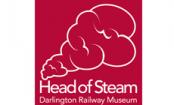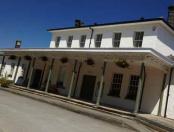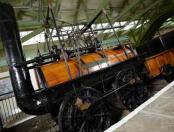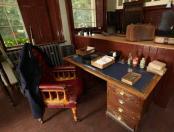North East - Tees Valley
![]()
HEAD OF STEAM, DARLINGTON RAILWAY MUSEUM
 North Road Station,
North Road Station,
Darlington
DL3 6ST
t: 01325 405060
e: headofsteam@darlington.gov.uk
w: www.head-of-steam.co.uk
Imagine stepping back in time to Victorian Darlington, the town that became known as the Birthplace of the Railways.



Venture into our original 1840’s railway station where time has stood still for over one hundred and fifty years.
Discover our Booking Office with its original Victorian interior.
Explore our platform that still has its original footbridge, waiting room, newspaper kiosk and Victorian toilets.
Follow the history of Darlington and the growth of the Railways through our permanent exhibitions and interactives.
Journey through time and admire our four historic locomotives including our star attraction, Stephenson’s Locomotion No1.
Head of Steam has something for all the family. We have a changing programme of temporary exhibitions and events, a meeting room for conferences and lectures, and children’s activity rooms for youngsters to learn and play.
The Museum has a fully equipped education room for use by schools and colleges and the Ken Hoole Study Centre is a research facility for railway and family historians (by prior appointment only).
We have a shop with souvenirs to suit all tastes and pockets and the Refreshment Stop provides hot and cold drinks and snacks.
Head of Steam - Darlington Railway Museum is located in North Road Station on the 1825 route of the Stockton & Darlington Railway, the world's first steam-worked public railway.
The museum is devoted to the area formerly served by the North Eastern Railway, with particular reference to the Stockton & Darlington Railway, and the railway industry of Darlington.
Exhibits include Stephenson's 'Locomotion No. 1', built for the opening of the Stockton & Darlington Railway, it is one of the oldest surviving steam engines in the world and the first ever steam train to carry fare paying passengers. 'Derwent' is the earliest surviving Darlington built locomotive. Both locomotives are on loan from The National Railway Museum.
A range of smaller items including station and lineside signs, uniforms, furniture, tableware and paintings, complement the larger exhibits. The entrance hall and ticket office are restored in period style, enhanced by displays of items such as porters' barrows, luggage, posters and advertising signs.
Opening Times
April – September Monday Closed
Tue – Sun 10am – 4pm
October – March Mon/Tues Closed
Wed - Sun 11am – 3.30pm
(We are closed on Christmas Day, Boxing Day and New Year’s Day)
Day Passes:
Adult £4.95
6-16 yrs old £3.00
Concession £3.75
5 yrs and under Free
Family Day Pass £10.00
Annual Membership:
Single Membership £10.00
Family Membership £15.00
Groups and coach parties
For groups of 10 or more you receive one free pass for every 10 paying visitors. For every group of 30 people or more the travel operator goes free too!
History of the Stockton and Darlington Railway
The Stockton and Darlington Railway was opened on September 27th 1825 with the prime purpose of transporting coal from the South West Durham collieries around Shildon, West Auckland and Witton Park, to the River Tees at Stockton, for shipment to the south of England.
The Stockton & Darlington was by no means the first railway, but its opening in 1825 marked a very significant step in the development of railways by bringing together two features for the first time:
- the concept of a public railway, available to all, for transport of passengers and goods
- the use of steam locomotives
The ceremonial opening on 27 September 1825 was the first occasion on which a steam locomotive was used to haul passengers on a public railway. The locomotive concerned, Stephenson's 'Locomotion' still exists and is displayed at Head of Steam, which is situated on the original 1825 S & DR route.
The new railway soon proved to be a great success and substantially reduced the price of coal. From the early years of the Stockton and Darlington Railway, private contractors using horse-drawn coaches on S & D R lines provided passenger services. After several years the economic potential for carrying passengers was evident and the Company introduced its own steam hauled passenger services in 1833.
Although the S & DR made use of steam locomotives from its opening day, it can also be seen to represent a transitional stage of railway development in which stationary engines and horse-drawn vehicles were also utilised. Although 'Locomotion' represents a notable development of the earlier pioneering work of George Stephenson and others, it is fair to say that the subsequent work of Timothy Hackworth, the first Superintendent Engineer of the S & DR, proved the supremacy of the steam locomotive over other forms of motive power.
From these origins there developed the major railway engineering industries of both Darlington and Shildon, which were to play an important role in supplying both the home and export markets. The initial success of the S & DR encouraged the promotion of branch and connecting lines. A branch opening in 1830 was instrumental in the development of the new town of Middlesbrough, which was to become a major industrial centre. Further extension, through a separate company promoted by the S & DR, took the line to Saltburn, which another associated company developed as a holiday resort.
Westward extensions into Teesdale and Weardale facilitated both the exploitation of the area's mineral resources and the transport of agricultural produce. Other lines in the S & DR network established vital links for development of the iron and steel industry at Consett and through the Stainmore route across the Pennines, in West Cumberland. These examples give an indication of the wide-ranging economic and social benefits which resulted from development of the S & DR and associated lines; a feature which was to be repeated not only in other areas of this country, but throughout the world. Also significant is that the S & DR was successful commercially, paying dividends to its shareholders and thereby encouraging the investment that was essential for the construction of other railways.
Head of Steam - Darlington Railway Museum, Station Road, Darlington, DL3 6ST
Telephone: 01325 405060
E-mail: headofsteam@darlington.gov.uk
Website: www.head-of-steam.co.uk


















